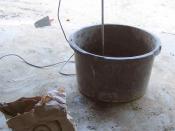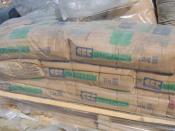Finishing Concrete The process of finishing concrete is a fairly complex procedure in that several steps are needed. The first step is mixing, which contributes to the whole foundation of good concrete. The ingredients in concrete are water, cement, Portland cement and aggregate or gravel. The concrete is usually mixed at a mixing plant prior to delivery to job site, unless a small amount is to be desired then you can mix it yourself. From the plant the concrete is carried to the site in a mixing truck where it is churned approximately eighty times prior to placement at the site.
The forms are usually wood or steel and should be built strong enough to hold the amount of concrete to be poured. The placement of the concrete is critical because if not properly poured, segregation can occur. Segregation is the separation of the cement from the other ingredients such as the aggregate.
After pouring workers with shovels move the concrete around to achieve a level surface. Then they use tools like giant levels to accomplish a more accurate and level surface. Floating is the process of leveling off the concrete and getting rid of excess moisture trapped in the concrete. When floating is done, workers on special boards smooth out the surface even further with edging and troweling.
Several slab finishes can be accomplished with the proper technique. The first is called exposed aggregate and is done by simultaneously brushing and spraying the surface with water. The second is called dry shake and produces any number of colors or textures. Throwing a dry powder mix on the surface after it has been floated and is free of excess moisture does it.
Several problems can occur in concrete if it is not properly finished. Crazing is usually fine cracks that occur when shrinkage is evident. Scaling is the breaking away of the hardened concrete surface of a slab to a depth of about 1/8 to 3/16 in. This occurs when it is subjected to a number of freezing and thawing cycles. Sometimes deicing will contribute to this.
Concrete can be kept moist in a number of ways, including leaving its forms in place, sprinkling, ponding, and using moisture retention covers or a seal coat that is applied as a liquid and then hardened to form a thin membrane. Curing methods that use water, such as sprinkling, ponding, and using wet coverings are the most effective means and should be used when ever practicable.
Temperature affects the rate of chemical reactions between Portland cement and water. Consequently, temperature affects the rate at which concrete hardens, as well as in its strength and other properties. The length of curing time should always be long enough for concrete to develop adequate strength before a load can be applied. Curing should be started as soon as possible to apply a curing medium without damaging the surface and should continue as long as is practicable. The steps in this essay should enable anybody to pour concrete with a little common sense of their own.



